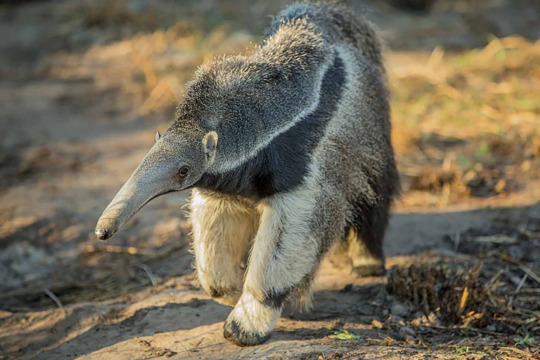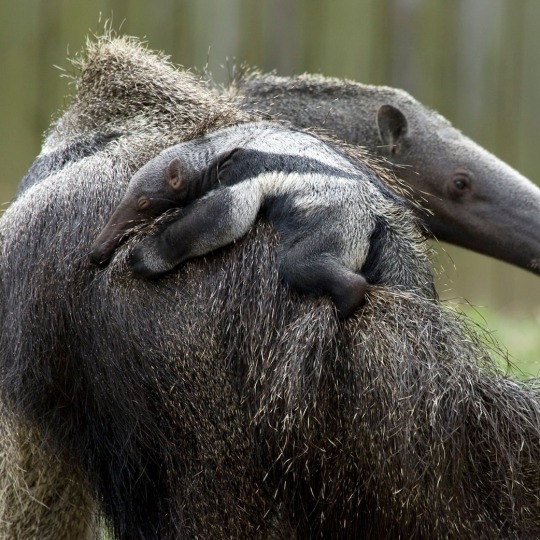#Myrmecophaga Tridactyla
Explore tagged Tumblr posts
Text

Anteater 2 - You Are What You Eat - in pastel and Ink by Graham Wallwork
20 notes
·
View notes
Text

横顔の影が素敵ですね〜
@日本平動物園
Nice shadow
@Nihondaira Zoo
213 notes
·
View notes
Text

Giant anteater, Myrmecophaga tridactyla.
44 notes
·
View notes
Text


#poll#Class: Mammalia#Order: Pilosa#Family: Myrmecophagidae#Genus: Myrmecophaga#Myrmecophaga Tridactyla#Range: Neotropical
64 notes
·
View notes
Text





Giant anteater (Myrmecophaga tridactyla), family Myrmecophagidae
Giant anteaters walk on their knuckles, keeping their foreclaws sharp. They use these claws to dig for food, but also to fight off rivals or attacking predators. Unlike their front claws, their hind feet have short claws, and walk plantigrade (like humans).
Avifauna, taken July 2024 (first picture) and Dierenpark Zie-ZOO, taken August 2024 (other pictures)
#animals#zoo#zoo photography#nature#giant anteater#Myrmecophaga tridactyla#myrmecophagidae#anteaters#anteater#avifauna#dierenpark zie-zoo
38 notes
·
View notes
Text

The Great Anteater by Joseph Wolf Postcard
Animal Illustration: Designs & Collections on Zazzle
#joseph wolf#illustration#vintage illustration#animal illustration#nature illustration#wildlife illustration#postcard#postcards#postcard art#animals#mammals#myrmecophagids#giant anteater#anteater#myrmecophaga tridactyla
29 notes
·
View notes
Text

The Great Anteater (Myrmecophaga jubata) | Joseph Wolf | Zoological sketches v.1 (1861) | Biodiversity Heritage Library | Flickr | Public domain
10 notes
·
View notes
Photo

Myrmecophaga tridactyla
15 notes
·
View notes
Text

Giant Anteater (Myrmecophaga tridactyla), family Myrmecophagidae, order Pilosa, found over much of South America
photograph by Vinicius Alberici
253 notes
·
View notes
Text
— Recent giant anteater sightings in Rio Grande do Sul state indicate the species has returned to southern Brazil, where it had been considered extinct for more than a century.
— Experts concluded that the giant anteater ventured across the border from the Iberá Park in northeastern Argentina where a rewilding project has released around 110 individuals back into the habitat.
— The sightings emphasize the importance of rewilding projects, both to restore animal populations in specific regions and help ecosystems farther afield.
— Organizations across Brazil are working to protect and maintain current giant anteater populations, including rallying for safer highways to prevent wildlife-vehicle collisions that cause local extinctions.
Playing back hours of footage from a camera trap set in Espinilho State Park in the south of Brazil in August 2023, Fábio Mazim and his team banked on possible sightings of the maned wolf or the Pantanal deer and had their fingers crossed for a glimpse of a Pampas cat (Leopardus pajeros), one of the most threatened felines in the world.
What they didn’t expect to see was an animal long presumed extinct in the region. To their surprise, the unmistakable long snout and bushy tail of a giant anteater ambled into shot.
"We shouted and cried when we saw it,” the ecologist from the nonprofit Pró-Carnívoros Institute told Mongabay. “It took a few days to grasp the importance of this record. A sighting of a giant anteater was never, ever expected.”
Last seen alive in the southwest of the Rio Grande do Sul state in 1890, the giant anteater (Myrmecophaga tridactyla) has since been spotted 11 times since August 2023, although the scientists are unsure whether it’s the same one or different individuals. However, the sightings confirm one clear fact: The giant anteater is back.
It's a huge win for the environment. Giant anteaters play an important role in their ecosystems, helping to control insect numbers, create watering holes through digging and are prey for big cats such as jaguars and pumas.
The habitat of the giant anteater stretches from Central America toward the south cone of Latin America.
Its conservation status is “vulnerable,” although it is considered extinct in several countries, including El Salvador, Guatemala and Uruguay, as well as specific regions such as the states of Rio de Janeiro, Espirito Santo, Santa Catarina and (until now) Rio Grande do Sul in Brazil and the Cordoba and Entre Rios regions in Argentina.
In the last six months, the giant anteater was spotted on camera 11 times in the Espinilho State Park in the state of Rio Grande do Sul in Brazil. It was the first time in 130 years that the species has been seen alive there.
Yet not only is it a triumph for conservationists to see these animals returning to Brazilian biomes, it’s also a surprising mark of success for a rewilding program about 150 kilometers (93 miles) away in neighboring Argentina.

Rewilding Argentina’s biomes
Iberá National Park in Corrientes province in northeastern Argentina is a 758,000-hectare (1.9 million-acre) expanse of protected land comprising a part of the Iberá wetlands with its swaths of grasslands, marshes, lagoons and forests. The region was once home to just a handful of giant anteaters after habitat loss, hunting and vehicle collisions decimated the population.
Since 2007, the NGO Rewilding Argentina, an offspring of the nonprofit Tompkins Conservation, has been reintroducing the species back to the area, most individuals being orphaned pups rescued from vehicle collisions or poaching.
So far, they have released 110 giant anteaters back into the wild. Nowadays, several generations inhabit the park, transforming it from “a place of massive defaunation to abundance,” Sebastián Di Martino, director of conservation for Rewilding Argentina, was quoted as saying in an official statement.
The project has been so successful that the giant anteaters appear to be venturing farther afield and moving to new territories beyond national borders, such as Espinilho State Park in Brazil’s Rio Grande do Sul region...
Experts now hope that a giant anteater population can reestablish itself naturally in Espinilho State Park without the need for human intervention.
“The giant anteater returning to Rio Grande do Sul shows the success of the work done in Argentina and how it’s viable, possible and important to do rewilding and fauna reintroduction projects,” Mazim said. “It is also an indication that the management of conservation units and also the agricultural areas of the ecosystems are working,” he added. “Because if large mammals are coming from one region and settling in another, it is because there is a support capacity for them. It is an indication of the health of the environment.”
-via GoodGoodGood, via May 25, 2024
#anteater#giant anteater#brazil#brasil#argentina#rewilding#conservation#conversation news#nature#biodiversity#environment#ecosystem#ecology#good news#hope
612 notes
·
View notes
Text

1K notes
·
View notes
Text

ほりほり
@東山動植物園
dig dig
@Higashiyama Zoo & Botanical Gardens
124 notes
·
View notes
Text

Get comfy, little guy—you’ll be there for a while! Did you know that a giant anteater (Myrmecophaga tridactyla) can spend the first year of its life on its mother’s back? This mostly solitary species, which can be found in Central and South America, roams a large territory: Each individual inhabits an area of up to 22,200 acres (9,000 hectares). Fortunately for mother anteaters, piggyback rides end before babies are fully grown. An adult giant anteater can weigh up to 85 lbs (39 kg)!
Photo: Smithsonian's National Zoo, CC BY-NC-ND 2.0, flickr
#amnh#science#museum#nature#natural history#animals#did you know#fact of the day#anteater#giant anteater#cute animals#baby animals
805 notes
·
View notes
Text

Get comfy, little guy—you’ll be there for a while! Did you know that a giant anteater (Myrmecophaga tridactyla) can spend the first year of its life on its mother’s back? This mostly solitary species, which can be found in Central and South America, roams a large territory: Each individual inhabits an area of up to 22,200 acres (9,000 hectares). Fortunately for mother anteaters, piggyback rides end before babies are fully grown. An adult giant anteater can weigh up to 85 lbs (39 kg)!
Photo: Smithsonian's National Zoo, CC BY-NC-ND 2.0, flickr
text credit: American Museum of Natural History
65 notes
·
View notes
Text
For #WorldAnteaterDay :

The Great Anteater, Myrmecophaga jubata (now M. tridactyla) Plate XXX in Zoological Sketches by Joseph Wolf (1820-1899), V.1, London, 1861 Via Biodiversity Heritage Library
🚨The Giant Anteater is a threatened species, currently listed as Vulnerable on the IUCN Red List.
#animals in art#animal holiday#19th century art#european art#anteater#Giant Anteater#threatened species#IUCN Red List#World Anteater Day#Joseph Wolf#natural history art#scientific illustration#sciart#historical sciart#zoological illustration#zoology#mammalogy#book plate#lithograph#BHL
29 notes
·
View notes
Text
Giant Anteater - Myrmecophaga tridactyla


The giant anteater is the largest out of the four species of anteater (the other three being the silky anteater, the northern tamandua, and the southern tamandua). This species is found mostly in grasslands, savanas, and rainforests ranging from the Honduras in Central America to the Gran Chaco region of Bolivia in South America. They tend to forage in open areas and rest in forested areas. During warmer seasons they are mostly nocturnal but will forage during the day when it is cooler. Giant anteaters are typically solitary creatures, mainly only coming together for breeding and when raising young.
The giant anteater has a typical body length of around 6 feet to 7 feet long (182 to 217 cm). Male and females weigh similarly, with females weighing slightly less. Their average weight range is from 60 to 110 lbs (27 to 50 kg). The head of the giant anteater is elongated with a cylindrical snout, making it perfect for reaching in and out of ant hills. Their tongue is approximately 2 feet long and extremely specialized, only moving forwards and backwards. This anteater has thick, bushy, and coarse grey-brown fur and white front legs with black ringed wrists and hands, and dark hind legs. From the throat to the shoulders is a thick black mark with white outlines and sharp tips. Their tail is extremely bushy and often used as a blanket or to shade them from the sun. Similar to apes like the chimpanzee, the giant anteater walks on its knuckles. This helps to keep their claws sharp for digging into ant mounds or for defense.
As their name implies, the giant anteater primarily feeds on ants, although it also feeds on termites. Their long tongue, which they use to feed, has small backward-pointing spines called papillae covered in sticky saliva that aid in feeding. Using its strong sense of smell, which is over 40 times as powerful as a human’s, the giant anteater detects ant mounds. It then digs into the mound before feeding, its tongue darting inside up to 150 times a minute. The anteater then rubs its tongue against its palate to smash the insects for swallowing.
All information is from Wikipedia and [here]. Images sources come from [here] and [here].
47 notes
·
View notes